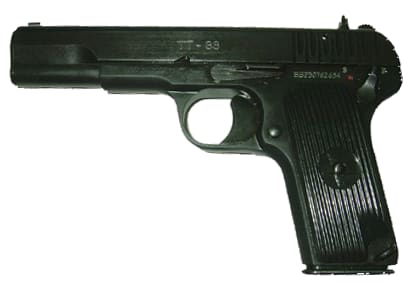

Takedown for cleaning is achieved by unloading the pistol completely and removing the magazine. The Soviet engineers also added several other features such as locking lugs all around the stainless steel five-inch barrel (not just on top), and made several alterations to make the mechanism easier to produce and maintain, notably a captive recoil spring secured to the guide rod which does depend on the barrel bushing to hold it under tension. This hammer assembly is removable from the pistol as a unique modular chassis unit and includes cartridge guides that provide reliable functioning. It employs a much simpler hammer/sear assembly than the M1911, with an external hammer. In other areas, the TT-33 differs more from Browning's designs. Nonetheless, the Tokarev, as well as its variants in 9x19mm, are renowned for its simplicity, light trigger, power, reliability, history and accuracy.Įxternally, the TT-33 is very similar to John Browning's blowback operated FN Model 1903 automatic pistol, but internally, it uses Browning's short recoil actuated, locked breech dropping-barrel with a swinging/drop link system from the M1911 pistol. To fix this problem, many shooters disassemble the pistols, remove them and restore the Tokarevs to the original configuration. However, a major complaint is the poor placement of the post-production safeties on the Mil-Surp guns that were hastily and cheaply installed to comply with US import regulations. In the US, the supply of surplus 7.62x25 ammunition has become scarce and it has become more expensive to shoot. The Tokarev is popular with pistol collectors and shooters in the West because of its ruggedness and reliability. The TT-33 pistol is also occasionally supplied to the People's Armed Police in China under the designation Type 54. Pakistani police also frequently use the TT as their sidearm, although they are being replaced by more sophisticated sidearms. As many as 53 different countries used the Tokarev pistol during its long history and dozens of other countries still use the Tokarev today, including Bangladesh and North Korea.

Poland, Romania, Egypt, Hungary, China, Romania, North Korea and even Pakistan have all made their own copies of the TT pistol. At one time or another most communist or Soviet east bloc countries in the Warsaw Pact made a variation of the TT-33 pistol, all of which were under different names. Production of the TT-33 in Russia ended in 1954, but copies (licensed or otherwise) were also made by other countries. The TT-33 was eventually replaced by the 8-round, 9×18mm Makarov PM pistol in 1952. Lieutenant Tay uses an M57 in First Blood Part II. The TT pistols were chambered for the small yet powerful 7.62 Tokarev pistol cartridge, which was high in velocity and capable of traveling at speeds of 1,500 to 1,800 feet per second, thus making it great for piercing armor such as steel helmets. It was developed in the early 1930s by Fedor Tokarev as a service pistol for the Soviet military to replace the Nagant M1895 revolver that had been in use since Tsarist times, though it never fully replaced the M1895. The TT-30 (Russian: 7,62-мм самозарядный пистолет Токарева образца 1930 года, 7,62 mm Samozaryadnyj Pistolet Tokareva obraztsa 1930 goda, "7.62x25mm Tokarev self-loading pistol model 1930" later improved into the TT-33) is a heavy, all-steel Russian semi-automatic magazine-fed pistol with a single-action only trigger system.


 0 kommentar(er)
0 kommentar(er)
